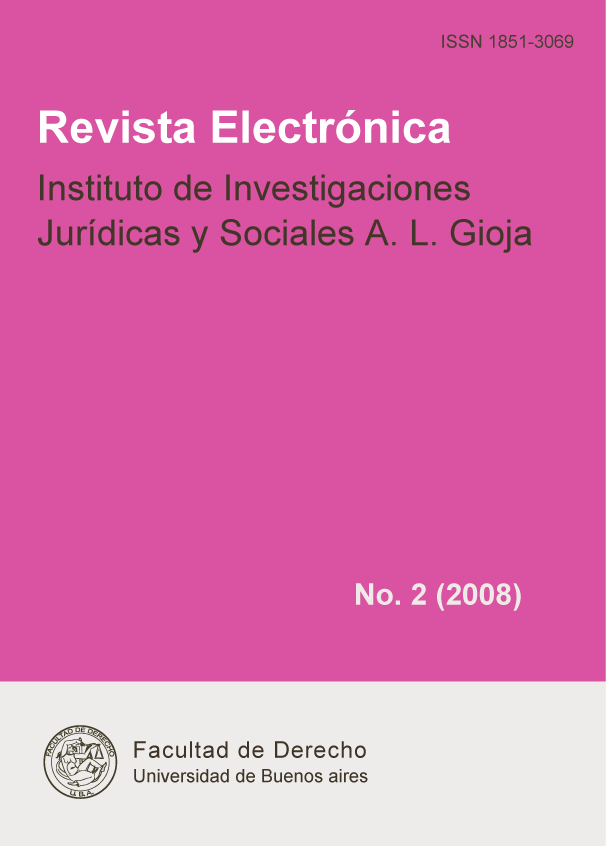EFFECTIVENESS OR INEFFECTIVENESS OF ECONOMIC INSTRUMENTS TO ACHIEVE ENVIRONMENTAL OBJECTIVES
Abstract
The article aims to show a sample of the instruments currently used to enforce the objectives of environmental regulations, focusing on their effectiveness. It has a first descriptive or enumerative stage. Then it begins to outline a classification, taking into account, as stated in the title, the economic or market tools and those that are not. Some preferences, as well as some objections, are substantiated. The mechanisms of the Kyoto Protocol are reviewed and a reflection is made on the payment for environmental services, highlighting the generalized absence of retribution for the use of the environment. A second stage is announced in which the effectiveness of the instruments will be evaluated and which will be based on the experiences being carried out, recalling the importance of raising awareness and the urgency of finding operational solutions. The title indicates that it is intended to fulfill two objectives 1) to show an overview, through a descriptive stage, of the tools in use to achieve behaviors that do not harm the environment and 2) an opinionated, evaluative stage, to assess the effectiveness of regulatory instruments. In the first, descriptive stage, the range of current resources to induce environmentally friendly behaviors will be presented. Not only the economic ones will be taken into account in order to establish comparisons.
Downloads
References
Coase, Ronald H., 1960 “ El problema del costo social”. Trabajo publicado originalmente en The Journal of Law and Economics (octubre 1960), pp. 1-44.
Convención marco de las Naciones Unidas sobre el Cambio Climático, 1992. Naciones Unidas GE.05-62301 (S) 220705 220705 United Nations Framework Convention on Climate Change, 1992. En especial anexos I y II.
EPA, 2003. “A Guide to Designing and Operating a Cap and Trade Program for Pollution Control En Tools of the Trade. United States Environmental Protection Agency Office of Air and Radiation EPA430-B-03-002 www.epa.gov/airmarkets June 2003.
FAO, 2007 El estado mundial de la agricultura y la alimentación 2007, la FAO, ORGANIZACIÓN DE LAS NACIONES UNIDAS PARA LA AGRICULTURA Y LA ALIMENTACIÓN, Roma, 2007 Colección FAO: Agricultura N° 38 ISSN 0251-1371.
La Cumbre del Clima Buenos. Aires, 2-13 de noviembre de 1998, Comercio de emisiones. Protocolo de Kyoto de la Convención Marco de las Naciones Unidas sobre el Cambio Climático Naciones Unidas, 1998. Nueva tirada por razones técnicas. FCCC/INFORMAL/83 GE.05-61702
(S) 130605 130605 Kyoto Protocol to the United Nations Framework Convention on Climate Change, 1997. En especial arts 6, 7 y 12.
OECD (Organización para la cooperación económica y el desarrollo), 2006 The Political Economy of Environmentally Related Taxes.(págs 1-8). Febr. 2007.
UNFCCC (2004) Cuidar el clima Guía de la Convención Marco sobre el Cambio Climático y el Protocolo de Kyoto Publicada por la Secretaría de la Convención Marco sobre el Cambio Climático (UNFCCC), Bonn (Alemania).
Downloads
Published
Issue
Section
License

This work is licensed under a Creative Commons Attribution-NonCommercial 4.0 International License.
Los/as autores/as que publican en esta revista están de acuerdo con los siguientes términos:
1. Los/as autores/as conservan los derechos de autor y garantizan a la revista el derecho de ser la primera publicación del trabajo al igual que licenciado bajo una Creative Commons Attribution-NonCommercial 4.0 International License que permite a otros compartir el trabajo con un reconocimiento de la autoría del trabajo y la publicación inicial en esta revista.
2. Los/as autores/as pueden establecer por separado acuerdos adicionales para la distribución no exclusiva de la versión de la obra publicada en la revista (por ejemplo, situarlo en un repositorio institucional o publicarlo en un libro), con un reconocimiento de su publicación inicial en esta revista.
3. Se permite y se anima a los/as autores/as a difundir sus trabajos electrónicamente (por ejemplo, en repositorios institucionales o en su propio sitio web) antes y durante el proceso de envío, ya que puede dar lugar a intercambios productivos, así como a una citación más temprana y mayor de los trabajos publicados (Véase The Effect of Open Access) (en inglés).














